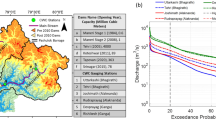Abstract
The East River basin is the major source of water supply for megacities in the Pearl River Delta and Hong Kong. Intensifying development of water resources and reservoir-induced hydrological alterations negatively affect ecological hydrological requirements. In this study, hydrological alterations and environmental flow variation are determined. Results indicate that: (1) multi-day maxima have reduced, while multi-day minima have increased, due to hydrological regulations of water reservoirs; (2) hydrological regimes of the East River have also been severely affected by hydropower generation, leading to a greater frequency of high and low pulses of lesser duration, and these effects are increasingly evident from the upper to lower East River basin; (3) owning to the water being released rapidly for hydropower generation or flood protection, the number of hydrologic reversals have increased after reservoir operations, also with increasing rise and fall rate; and (4) the alteration of three different types of environmental flow components have been shown in the study, which can be used to support the determination of environmental flow requirements in the East River basin.









Similar content being viewed by others
References
Arthington AH, Brizga SO, Kennard MJ (1998) Comparative evaluation of environmental flow assessment techniques: best practice framework. LWRRDC Occas Pap 25(98):26
Arthington AH, Bunn SE, Poff NLR, Naiman RJ (2006) The challenge of providing environmental flow rules to sustain river ecosystems. Ecol Appl 16(4):1311–1318
Chen YD, Yang T, Xu C-Y, Zhang Q, Chen X, Hao ZC (2010) Hydrological alteration along the Middle and Upper East River (Dongjiang) basin, South China: a visually enhanced mining on the results of RVA method. Stoch Env Res Risk Assess 24(1):9–18
Mathews R, Richter BD (2007) Application of the indicators of hydrologic alteration software in environmental flow setting. J Am Water Resour Assoc 43(6):1400–1413
Poff NL, Allan DJ, Bain MB, Karr RJ, Prestegaard LK, Richter DB, Sparks ER, Stromberg CJ (1997) The natural flow regime. Bioscience 47(11):769–784
Postel SL (1998) Hydrological for food production: will there be enough in 2025? Bioscience 48(8):629–637
Postel SL, Daily GC, Ehrlich PR (1996) Human appropriation of renewable fresh hydrological. Science-AAAS-Weekly Paper Edition 271(5250):785–787
Richter BD, Baumgartner JV, Powell J, Braun DP (1996) A method for assessing hydrological alteration within ecosystems. Conserv Biol 10(4):1163–1174
Richter B, Baumgartner J, Wigington R, Braun D (1997) How much hydrological does a river need? Freshhydrol Biol 37(1):231–249
Richter BD, Baumgartner JV, Braun DP, Powell J (1998) A spatial assessment of hydrological alteration within a river network. Regul Rivers Res Manag 14(4):329–340
Sparks RE (1992) Risks of altering the hydrological regime of large rivers. Predict Ecosyst Risk 20:168–182
Tharme RE (2003) A global perspective on environmental flow assessment: emerging trends in the development and application of environmental flow methodologies for rivers. River Res Appl 19(5–6):397–441
The Nature Conservancy (2009) Indicators of hydrological alteration version 7.1 user’s manual. http://www.conservationgateway.org/ConservationPractices/Freshwater/EnvironmentalFlows/MethodsandTools/IndicatorsofHydrologicAlteration/Pages/IHA-Software-Download.aspx
Wong JS, Zhang Q, Chen YD (2010) Daily urban water consumption in Hong Kong: trend, patterns, and forecast. Water Resour Res 46:W03506. doi:10.1029/2009WR008147
Zhang Q, Cui Y, Chen YD (2012) Ecological flow evaluation based on hydrological alterations in the Dongjiang River Basin. J Nat Resour 27(5):790–800 (in Chinese)
Zhou Y, Zhang Q, Li K, Chen X (2012) Hydrological effects of water reservoirs on hydrological processes in the East River (China) basin: complexity evaluations based on the multi-scale entropy analysis. Hydrol Process 26:3253–3262
Acknowledgments
This work was financially supported by The National Natural Science Foundation of China (Grant No. 41071020), Program for New Century Excellent Talents in University (NCET), and is fully supported by a grant from the Research Grants Council of the Hong Kong Special Administrative Region, China (Project No. CUHK441313). Our cordial gratitudes should be extended the editor, Prof. Dr. George Christakos, and two anonymous reviewers for their professional comments and revision suggestions which are greatly helpful for further improvement of this manuscript.
Author information
Authors and Affiliations
Corresponding author
Rights and permissions
About this article
Cite this article
Zhang, Q., Xiao, M., Liu, CL. et al. Reservoir-induced hydrological alterations and environmental flow variation in the East River, the Pearl River basin, China. Stoch Environ Res Risk Assess 28, 2119–2131 (2014). https://doi.org/10.1007/s00477-014-0893-4
Published:
Issue Date:
DOI: https://doi.org/10.1007/s00477-014-0893-4




